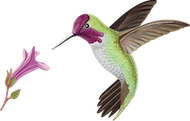As the Gottlieb Native Garden’s naturalist, Scott Logan documents the ever-changing array of wildlife species as they vary with the garden’s blooms, seasons and migratory patterns. While bringing these observations to life for all to experience, he also coordinates scientific research projects, and monitors the overall health and biodiversity of the garden. The Naturalist’s Journal also highlights the work the Gottliebs and Scott are doing to educate and inspire people to start gardening for wildlife with native plants.
carrion plant
The transformation of the GNG began in 1990, not as a California native garden, but as a drought-tolerant Mediterranean garden. But it wasn’t long before the connection between native plants and the survival of native wildlife was made. During the proceeding years, the majority of […]
GNG MOTUS Station
The Gottlieb Native Garden, in collaboration with Pasadena Audubon, installed a Motus Wildlife Tracking System in hopes of adding data to this international collaborative research project that uses radio telemetry to track flying animals. Motus collaborators have contributed to hundreds of academic publications covering a […]
decorative nesting box
The GNG has many nesting boxes throughout the garden, supplying secondary cavity nesting birds with important habitat to raise their families. As long as the box is of appropriate dimensions and placed in the proper niche, it will be considered as a nesting site. A […]
Silk Moths Rock!!!
We don’t see Ceanothus silkmoths in the garden often, but when they appear – WOW – they never fail to impress! These beautiful large moths have a wingspan of up to 5”. In the greater Los Angeles area, they most often fly between the months […]
Coopers Hawk with prey
I was alerted to a predator in the Garden by the chorus of bird and squirrel alarm calls. When I located the marauder, I wasn’t surprised to find a Cooper’s Hawk with prey. What did surprise me was what the hawk had caught – a […]
Orange Sulphur
The Orange Sulphur, or Alfalfa Butterfly, is common throughout most of North America but this is the first time finding one in the GNG. Nudges our butterfly list up to 29 species! Orange Sulphur – Colias eurytheme
End of the 2023 Oriole season
As the end of the 2023 oriole season approaches, the birds have been at the nectar and mealworm stations non-stop. It’s critical that Hooded Orioles put on enough fat reserves to get them to their wintering grounds in Western Mexico. This is always a sad […]
Blow Flies Fooled By Fungus
Lantern Stinkhorn ingeniously combines a smelly odor with a fruiting body that imitates rotting flesh. How does this benefit the fungus? Blow flies arrive believing they have found fresh carrion in which to lay their eggs. As the flies investigate, they walk on sticky gleba-bearing […]
Influx of White-lined Sphinx Moths
The White-lined Sphinx Moth ranges over the entire United States and is very common here in Los Angeles. California is one of the few states where the moth can be found flying year round. With that said, they are usually only seen in numbers during […]
Robins, Robins and more Robins!
Huge numbers of American Robins have been flocking all around Southern California in one of the largest congregations in many decades. Southern California always gets an influx of robins during the winter months, but it’s not clearly understood why they are here now in such […]

